NZXT H630 Silent Case Review
by Dustin Sklavos on May 14, 2013 10:00 AM EST- Posted in
- Cases/Cooling/PSUs
- NZXT
- ATX
Noise and Thermal Testing
I've mentioned before that when I go into actually testing a case, I generally have a decent idea of how it's going to perform. That wasn't true with the NZXT H630, though; most silent cases use some combination of 120mm or 140mm fans for the front intake and then a single one in the rear. In the H630, on the other hand, NZXT used a massive 200mm intake fan. At the same time, though, I was skeptical as to whether or not the ventilation in the front would really be adequate.
Our stock testing configuration is in many ways a best case solution (no pun intended) for testing silent cases, as the hardware isn't being pushed too hard and the sound-dampening materials are allowed to do their job. Unusually, NZXT doesn't include fan control with the H630, instead opting to just try to include quiet fans in the first place.
Ambient temperature was roughly 23C during testing.
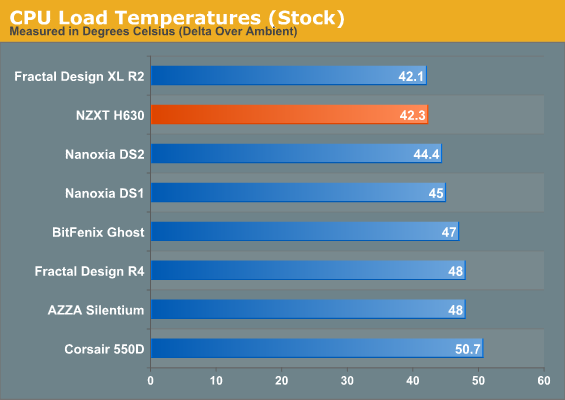
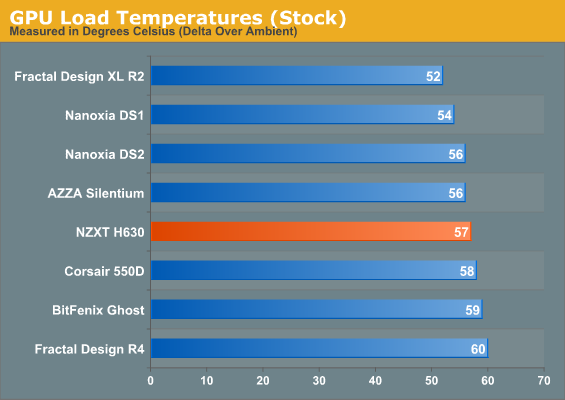
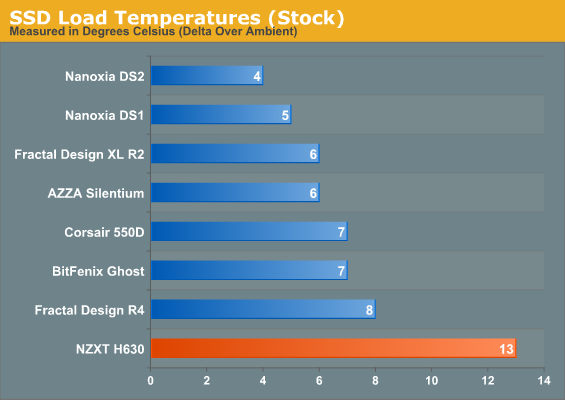
Stock thermals are generally good. The SSD is running toasty, but it has no direct airflow behind the motherboard tray, and it's still well below spec. The queen bee that NZXT has to contend with is the Nanoxia Deep Silence 1 (as well as the Deep Silence 2); while the DS1 doesn't offer exceptional performance in the standings, it has a stellar blend of thermals and acoustics and handles that balancing act very well.
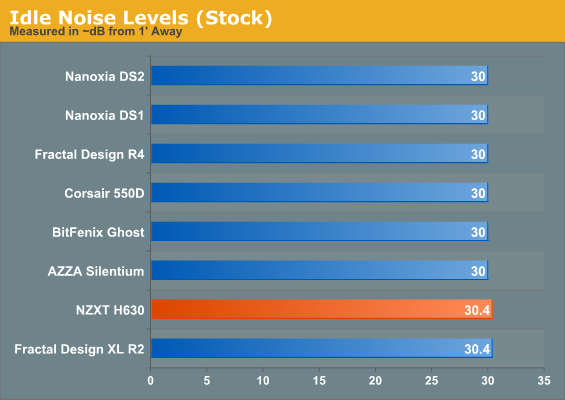
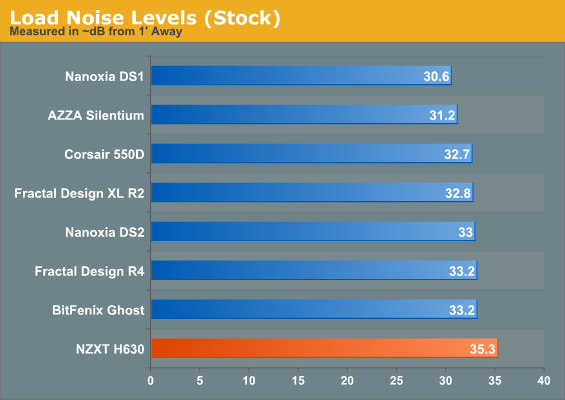
Unfortunately, fan noise is a real problem for the H630. Interestingly, though I was of the impression that there wasn't enough ventilation for the H630, I might have been wrong. The H630 is the loudest "silent" case I've tested under load. This is one of those places where Nanoxia's Deep Silence 1's chimney turns out to be a killer feature; the design of it muffles noise without crippling airflow.

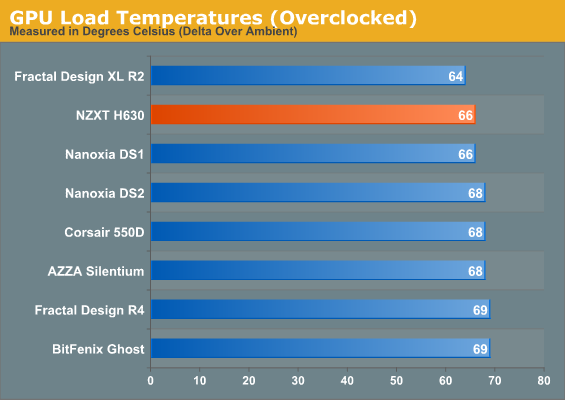
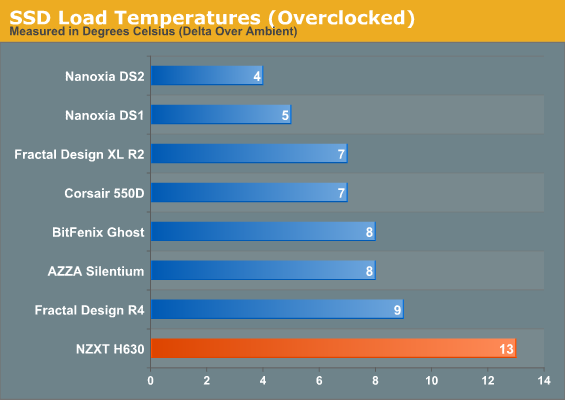
Our overclocked testbed's thermals are where the screws start really getting put to the H630. Thermally it keeps pace with the Deep Silence 1, though Fractal Design's competing Define XL R2 puts in a much stronger showing.
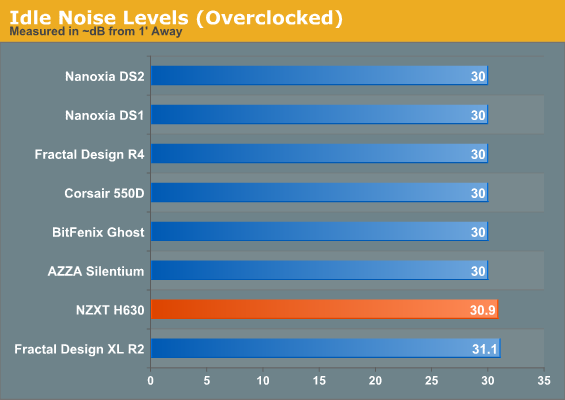

Interestingly, the H630's fortunes turn when noise levels are measured. While idle noise remains less than ideal, load noise is surprisingly strong, even performing slightly better than the Deep Silence 1 and 2.
Unfortunately I don't have results for any of the silent cases we've tested using our freshly minted "full fat" testbed, so we'll have to see how the H630 fares against the other cases that were tested after we put together that bed. This is for all intents and purposes not a fair fight, but should at least be somewhat educational.

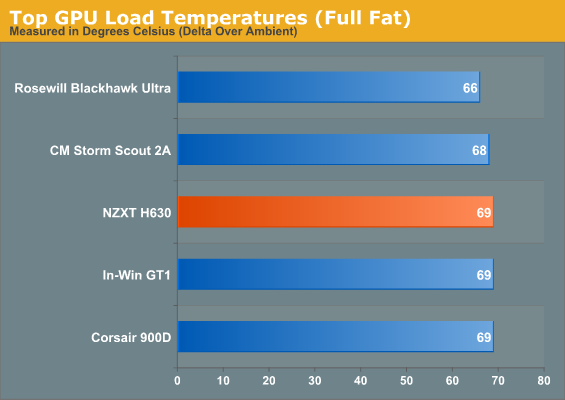
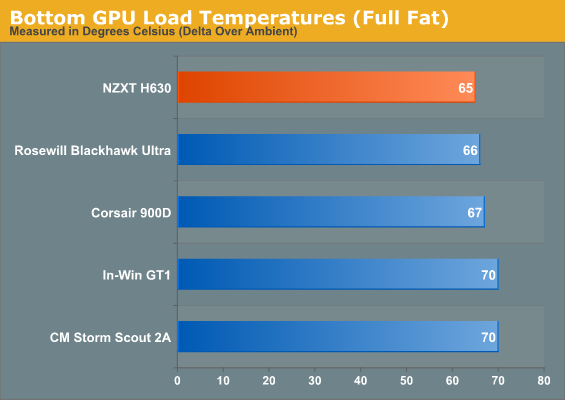
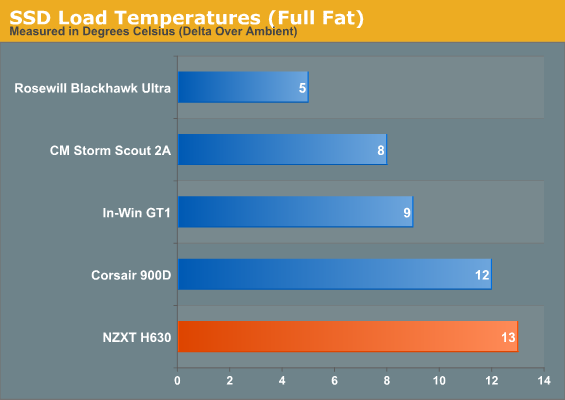
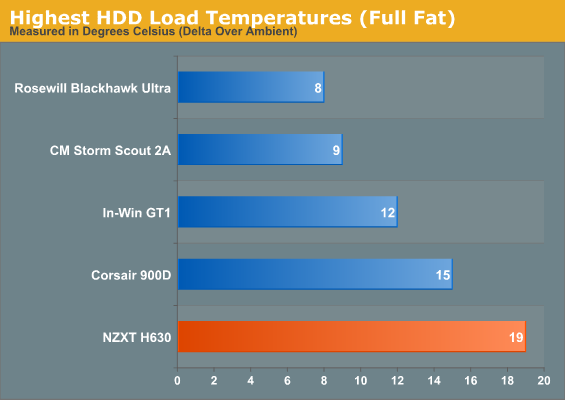
Results aren't great but they're not completely terrible either, and under the circumstances the H630 actually performs pretty admirably. Note that the hard drive thermals are a product of a conscious decision to employ the topmost hard drive cage instead of the bottom. I elected to keep airflow clear for the rest of the case as opposed to having cool air directly flow over the hard drives, and a small heat pocket does develop in the top without active air flow.
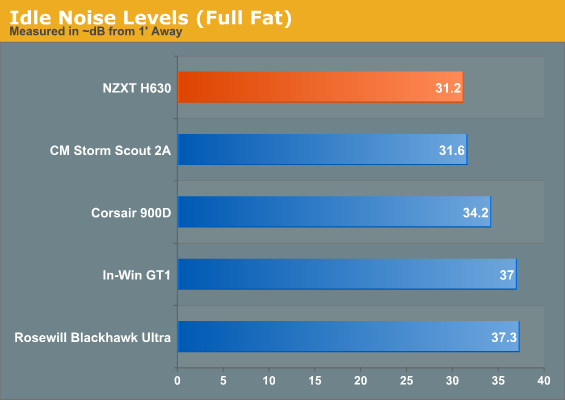
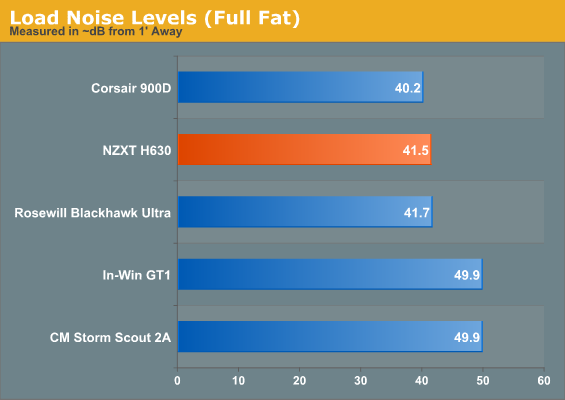
Noise levels aren't great, but they're actually very competitive, all things considered. NZXT targets the H630 for cooling and silencing high-powered components, and while it seems to have had at least some trouble doing that (as have the other competitors), it at least has potential.










27 Comments
View All Comments
zero2dash - Tuesday, May 14, 2013 - link
This case won me on looks but the thermal/noise results leave a little to be desired. It definitely has a very nice feature set though, with the included SD card reader and the fan distribution block on the back side of the motherboard tray.lwatcdr - Tuesday, May 14, 2013 - link
I would say that it needs more fans running slower. As a reviewer you have a big problem with a case like this. Do you review it with just the fans installed? Seems like they mean for you to install more fans. Do you install both an air cooler and an AIO cooler? If so which coolers do you pick? The best value, the best performance? Over all it is a difficult taks because if the reviewer loads it up with good fans and AIO coolers it will perform better than out of the box but what about the guy that buys it and just wants to stick a board in it. I bet this case with the right fans and coolers will work very well. But then that is probably true of most cases.BlueReason - Saturday, May 18, 2013 - link
Unless you plan on installing the exact same build and don't plan on utilizing any of the fan placement options, the thermal/noise measurements are about as meaningful as Dustin measuring how well the case matched his office furniture.mr_tawan - Tuesday, May 14, 2013 - link
I'd prefer the control panel (power switch, reset, usb, card reader, etc...) to be on the top instead of on the right side. Still better than the one I'm using (CM Centurion 5, which the power button is just a little bit above the ground. It's not a silent case btw.).lwatcdr - Tuesday, May 14, 2013 - link
Are any of the fans filtered?JDG1980 - Tuesday, May 14, 2013 - link
I asked this question to a NZXT rep on techPowerUp and was advised that, yes, the fan intakes are filtered.DanNeely - Tuesday, May 14, 2013 - link
If you look at the page2 gallery you can see the mesh filters on the bottom intake fans.jagerman - Tuesday, May 14, 2013 - link
I bought a NZXT H2 case a couple of years ago, which I suppose is the (a?) predecessor to this case, being designed for quiet operation. I must say, it disappointed me enormously.For starters, the case was significantly starved for air, but I knew that already, and wasn't putting a particularly hot system inside, so I was okay with that. Judging from the article, NZXT didn't learn anything: this system seems to follow in those footsteps: it's louder and hotter than the competition for even a medium powered system.
A bigger problem with the H2, and carried through to this system, was that the drive cages were miserably painful to use: hard to get drives in and hard to get drives out of, with sharp metal edges on the drive plugs that seemed to have a tendency to cut under your fingernails. On top of that they're flimsy, as noted in the article. Furthermore they are unidirectional: unlike drive rails on most other cases in this category, you can't choose which way you want your drive cables to run. Apparently, those shitty drive rails are still here, and it's as good a reason as any to avoid the case.
The other big problem with the H2 didn't appear until a year or so later, when I swapped out my hardware between cases: all of the rubber parts (on the drive trays, and around the holes on the motherboard) had deteriorated to feel chalky rather than soft, and left disgusting black smudges on anything that even brushed them lightly: skin, cables, screwdrivers, whatever. The cables running through the rubberized cut-outs were permanently stained dark black at the point they went through. My hands, after swapping the system out, looked like I had been playing in soot for an hour, and needed a thorough scrubbing afterwords (the black crap did not come off easily).
From that experience, I'll never buy another NZXT case: they seem designed for very short term use, perhaps engineered to last long enough to make reviewers happy, but are using cheap, substandard parts that they don't seem to care about changing. There are other people in the quiet case market doing a much better job on all of quality, noise, and price; NZXT failed with the H2, and judging from the results and the lack of fixes from the H2's design flaws, that they've failed again with the H630.
Dustin Sklavos - Tuesday, May 14, 2013 - link
There's been a major sea change in the way cases are being designed at NZXT since the H2. If the H630 appeals to you I'd recommend it. It's far superior to the H2.Hrel - Tuesday, May 14, 2013 - link
Fractal remains King of Mid-Tower. (My title for this piece)